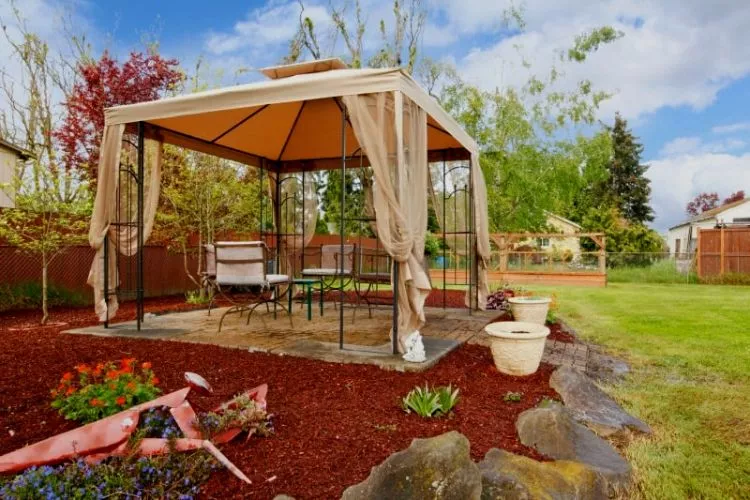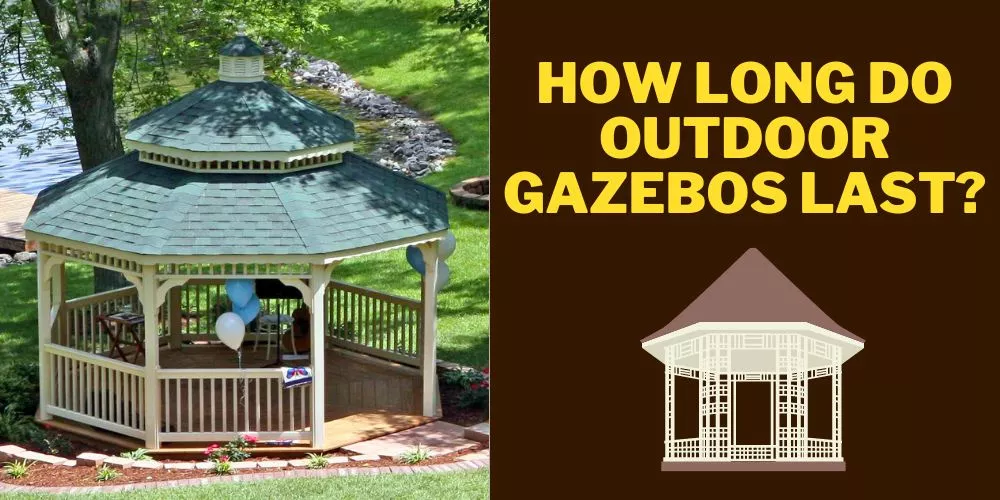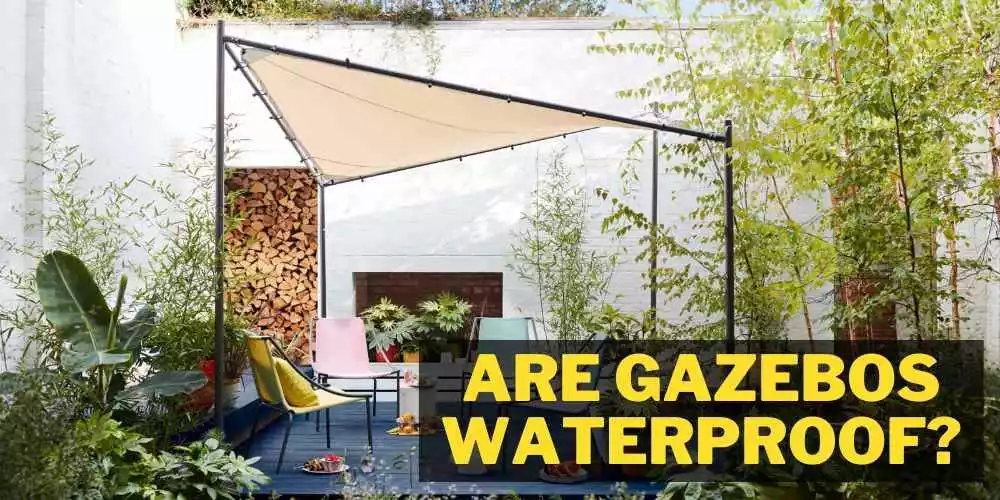Dyeing or painting a gazebo covering will add some much needed zest and help protect and prolong their lifespan.
The DIY and craft space has been bonkers for this practice recently. Mostly because some of the finished results are mind blowing, but the simplicity of doing so also makes it a joy of a project to partake in.

There are several ways to spruce up an aging gazebo cover.
In this article, we’ll go through the different methods step by step and distinguish the benefits and drawbacks of paints vs stains. Let’s dive in, shall we?
Can you dye gazebo cover?
Yes, you can dye gazebo, using dyes, stains and paints is a great way to give these gazebo parts a facelift without breaking the budget.
But, it’s important to determine if dyeing a gazebo cover is feasible. Start by checking the materials of your gazebo cover. Most gazebo covers are made of polyester fabric, which is dyable.
However, some may be made of vinyl or other materials that are not suitable for dyeing. Ensure that your gazebo cover is made of polyester or a dyeable fabric before proceeding.
You can add some much needed life to many areas of a gazebo. However, the cover or canopy is the most commonly altered part as they tend to wear out much faster. This is often due to harsh suns, heavy winds and rains, and even snow in some locations.
Of course, the method of touch up is governed by the gazebo type. For example, pop up, and hardtop gazebos usually have covers or canopies that can be dyed. Whereas permanently built gazebos have roof systems constructed with timbers and/or metals that are more suited to paints and stains.
How To Dye Gazebo Cover?
Gazebo covers and awning canopies can be dyed. This action is performed to help extend the lifestyle of shelter and roofing materials. It is also a great way to improve the look of these outdoor coverings and make them look more uniform with a structure that they may be erected next to. DIY dyeing both gazebo covers and canopy awnings can be done using the same principles.
One thing to note is that some water resistant covers cannot be colored as the synthetic or polyester-based canvas material won’t soak the dye in. Furthermore, you need to get paint or dye specifically designed to be used on cover/awning materials as opposed to walls, roofs, etc.
There are a couple of different methods to dye a gazebo cover. You can do it manually by using a washing machine or painting it on. In this article, we’ll go through the process of dyeing it manually, using a washing machine to clean the cover, and then finishing it off with a washing machine. All it takes is a few simple home staple ingredients.
Materials needed
- 20L-50L bucket or pot that can handle reasonably hot water (You will be using this to dunk your cover/canopy in as well as the water, so the bigger, the better, if possible)
- Smaller 5L-10L container to premix and dissolve the dye solution first
- A third container to mix salt and water (5L is ample)
- Latex/rubber gloves
- Something to stir with (stainless steel or wooden spoon)
- Mild laundry soap
- Disperse dye powder or paste
- 1 cup Salt
- 4 cups hot water
- Access to more warm water to rinse off the cover once complete
- Extra towels to mop up
- An open area to work on and somewhere to hang the cover up once complete
Preparation
- Before you can dye the cover, you should first give it a good clean. This will ensure that no remaining remnants prevent the dye from soaking in.
- So go ahead and remove the cover or canopy from its gazebo framework. This may involve unstrapping some velcro, unclipping some buttons, or even sliding it to one end of the frame before completely drawing it off.
- Once the cover is free, throw it in the washing machine with some mild laundry soap. Use a setting where the water is between 60°F- 100°F (16°C- 38°C).
- Remove the cover from the machine and hang it up, allowing it to dry out completely before proceeding further. Do not place it in the dryer!
Dyeing the cover
- Before you begin anything, wear some protective, latex rubber gloves.
- Fill the larger container just under halfway with hot water. It doesn’t have to be boiling, but it should be hotter than ‘just warm.’ Allow enough room for the cover and dye as you add it.
- Mix the dye powder or paste in the medium container with water according to the packet instructions. (All dyes are different, so it’s difficult to say exactly how much here). Before adding it to the larger container, you want this solution to be completely dissolved.
- Mix the 1 cup of salt with 4 cups of hot water in the 3rd container and make sure the solution is completely dissolved. Once dissolved, add it to the large container with the dissolved dye.
- Now it’s time to place the cover into the hot water, dye, and salt water solution and submerge it. Make sure you have some towels handy to mop up if need be, and always wear protective gloves when working with these types of chemicals.
- Some dyes take longer than others to reveal their colors. At this stage, you’ll want to move the cover around every 10-15 mins while submerging it until the desired color is achieved.
- Once your cover is the color you want, run it under warm water for several minutes until it is clear. This is a sign that no more dye is present.
- Throw the cover in the washing machine and run a normal cycle with hot water. Always wash covers like this separately.
- Hang the cover up to air dry and reattach it to the gazebo once it is completely dry. Enjoy!
Maintenance and care
It’s recommended to wash gazebo covers every 6 months, depending on usage. This can be done by simply throwing the cover in the washing machine on a normal cycle with medium heat. Hang it out to air dry as you did when dyeing. Another action you can take is spraying on a water resistant sealer to give it a bit of extra strength when it comes to battling any weather conditions.
Is it better to paint or stain a gazebo?
When it comes to protecting an actual gazebo frame, there are a couple of ways in which this can be done. Let’s talk about staining vs painting. Staining is a great option for timber treatment because it soaks in deep and prevents moisture from penetrating. You can add multiple layers and know that the first layer completely seals the timber from moisture.
Whereas paint can also work well, it’s usually used as an extra layer or layers over the timber. Paint doesn’t generally soak in, so if there are any cracks or damaged areas of the paint, moisture will find its way into them. Of course, you can prime timber for extra bondage and sealant, but it isn’t always guaranteed. Furthermore, stains look much more natural compared to paints that can be any color you choose.
What lasts longer, outside paint or stain?
When comparing both methods for longevity, the overall result is governed by the detail taken to prepare the timber before application. Preparation aside, paint can last anywhere up to 10 or so years before it needs to be reapplied. You’d usually use a primer to help the next coat bond and seal. 2-3 coats are generally quite reliable.
At the same time, staining needs a more consistent reapplication to maintain its strength and purpose. You may need to repaint stains every 2-3 years, but in doing so, you’re adding a lot more life to your gazebo framework. Thorough preparation will ensure a smoother finish and help to prevent moisture from penetrating the timber once treated.
Maintaining Your Newly Dyed Gazebo Cover
To ensure the longevity of your newly dyed gazebo cover, it’s essential to follow some maintenance guidelines. Here are a few tips:
- Avoid using harsh chemicals or abrasive cleaners on the cover, as they can fade the dye or damage the fabric.
- Clean the cover regularly by gently washing it with warm water and a mild detergent to remove dirt and debris.
- Avoid leaving the cover exposed to direct sunlight for extended periods. Over time, excessive sun exposure can cause fading.
- Consider using a UV protectant spray specifically designed for fabrics to shield your gazebo cover from harmful UV rays.
Frequently Asked Questions (FAQs)
What kind of paint do you use on a gazebo?
Latex is generally best for all round 4 season types of weathering. It can handle general wear and tear from foot traffic and furniture movement; it can also help protect against consistent rains, snowfall, and sun damage. It’s quite resistant to abrasions and helps to minimize any damage caused by moisture penetration below the top coats.
Can canvas material be dyed?
Canvas is one of the easiest materials to dye, and there are a number of methods to do so.
What is the best color for a gazebo?
The ‘best’ gazebo colors depend a lot on usage and/or personal preference. It’s quite common for gazebo owners to choose neutral colors these days. Whites, grays, and beige can be great choices if you’re trying to make any darker colors pop. For example, trees, bushes, climbers, furniture, etc. From a style perspective, it’s much easier to add lighter, neutral colors as opposed to darker colors that may already steal the spotlight.
Conclusion:
Dyeing the cover or canopy of your gazebo can be a rewarding experience. There’s nothing more invigorating than sprucing up something drab and boring and turning it into a centerpiece. The beauty of doing so is that it’s actually quite a simple task and doesn’t even really break the budget, either.
All you really need to do is get some inspiration and put your creative hat on. We hope that this guide regarding can you dye gazebo cover or not has been helpful. You can read about similar topics here on our website. Check back again soon for more.


